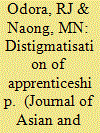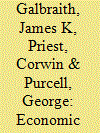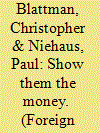|
|
|
Sort Order |
|
|
|
Items / Page
|
|
|
|
|
|
|
| Srl | Item |
| 1 |
ID:
133724


|
|
|
|
|
| Publication |
2014.
|
| Summary/Abstract |
The intention of this paper is two-fold; firstly, it is to explore the causal effect of perceived negativity towards Further Education and Training (FET) college education among South African youth. Secondly, it is to determine the impact of apprenticeship on the development of entrepreneurial knowledge and skills among FET college students. The FET sector serves a particular function, which is the imparting of hands-on vocational training, intended to inculcate and promote a culture of self-employment, considered a necessity for employment creation. A questionnaire was used to collect data from 112 randomly selected students from three Motheo FET colleges. The findings reveal very contrasting results, a direct correlation between apprenticeship and entrepreneurship; however, 53% of the respondents did not feel sufficiently equipped, ready and confident enough to start their own businesses after graduation. About 48% feel the need to further their studies at university in order to stand a better chance of landing a good job.
|
|
|
|
|
|
|
|
|
|
|
|
|
|
|
|
| 2 |
ID:
078978


|
|
|
|
|
| Publication |
2007.
|
| Summary/Abstract |
This paper tests a simple hypothesis: that given the occurrence of war between two countries, the country that is more egalitarian at the moment of military decision is likely to emerge the victor. First, we examine cases where comparative economic inequality can be measured directly, using the nearly comprehensive global datasets of the University of Texas Inequality Project for the years 1963-1999. Second, we examine cases where reasonable inferences about comparative economic inequality may be drawn by analogy to UTIP measurements or from other political and economic evidence, including both bi-national wars and larger wars where there existed clear pair-wise fronts. Third, we discuss selected cases where inferences may be drawn from literary or historical sources. We find, all in all, that the evidence for an egalitarian victory proposition is remarkably strong.
|
|
|
|
|
|
|
|
|
|
|
|
|
|
|
|
| 3 |
ID:
130473


|
|
|
|
|
| Publication |
2014.
|
| Summary/Abstract |
Every year, wealthy countries spend billions of dollars to help the world's poor, paying for cows, goats, seeds, beans, textbooks, business training, microloans, and much more. Such aid is designed to give poor people things they can't afford or the tools and skills to earn more. Much of this aid undoubtedly works. But even when assistance programs accomplish things, they often do so in a tremendously expensive and inefficient way. Part of this is due to overhead, but overhead costs get far more attention than they deserve. More worrisome is the actual price of procuring and giving away goats, textbooks, sacks of beans, and the like.
Most development agencies either fail to track their costs precisely or keep their accounting books confidential, but a number of candid organizations have opened themselves up to scrutiny. Their experiences suggest that delivering stuff to the poor is a lot more expensive than one might expect.
Take cows. Many Western organizations give poor families livestock, along with training in how to raise and profit from the animals. Cows themselves usually cost no more than a few hundred dollars each, but delivering them -- targeting recipients, administering the donations, transporting the animals -- gets expensive. In West Bengal, India, for example, the nonprofit Bandhan spends $331 to get $166 worth of local livestock and other assets to the poor, according to a report by the rating agency Micro-Credit Ratings International. Yet even this program sounds like a bargain compared to others. In Rwanda, a study led by the economist Rosemary Rawlins found that the cost of donating a pregnant cow, with attendant training classes and support services, through the charity Heifer International can reach $3,000.
|
|
|
|
|
|
|
|
|
|
|
|
|
|
|
|
|
|
|
|
|